New book: Six Six Six
Six Six Six - One Hundred and Eleven Six-Word Stories About Hell came out on the 6th of June. It’s a project I’ve been working on for about seven or eight months (I wish I could say six, but other things have delayed it slightly) and some sneak preview copies were on sale at the Ink Paper & Print Fair last month.
As the title suggests, it’s a collection of six-word stories about hell, most specifically about the devil. The stories should work alone, but they join up to form a loose narrative from beginning to end. Here’s the first four:
Lucifer asked about opportunities in management.
As top performer, Lucifer wanted perks.
Word got out: Lucifer was ‘difficult’.
Meetings were held. Whispers: “Outcasting?” “Outcasting.”
It goes on from there, telling the story of Lucifer’s fall, rebirth and eventual war on Heaven. But in a fairly upbeat sort of way.
The book is available in three printings. First of all, there’s a handmade hardback, of which only six were made. Each one costs £66.60. These took quite a long time to make because I am by no means an expert bookbinder, but I’m pretty happy with how they turned out.
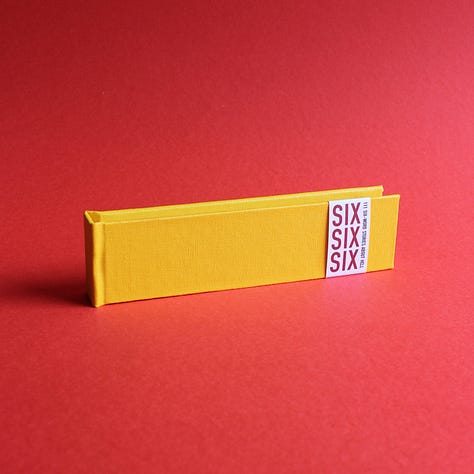
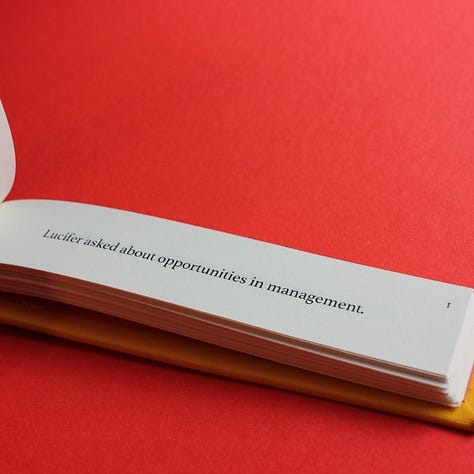
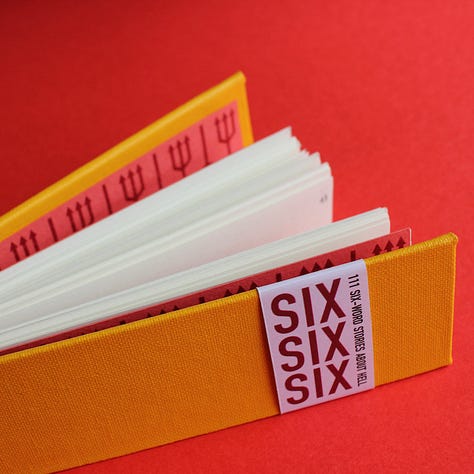
Then there’s what I think of as the ‘mass market’ paperback, of which there are sixty copies at £6.66 each. I made these by ordering paperbacks through a print-on-demand provider and chopping them up into littler books. This was one of those things that I thought would be straightforward, but proved surprisingly tricky. I tried outsourcing this to various facilities who had mechanical guillotines, only to find that the spines were crushed or the cut was uneven. I tried doing this for myself at the London Centre for Book Arts, using their ginormous guillotine, only to find that the wonkiness could only be avoided with huge amounts of paper in a cutting wedge. If I was still living in London, I would have gone back to do the whole run there, but since relocating to Lewes, I couldn’t be arsed to haul all the stuff on the train, so decided to do it at home, with a Stanley knife and a metal ruler.
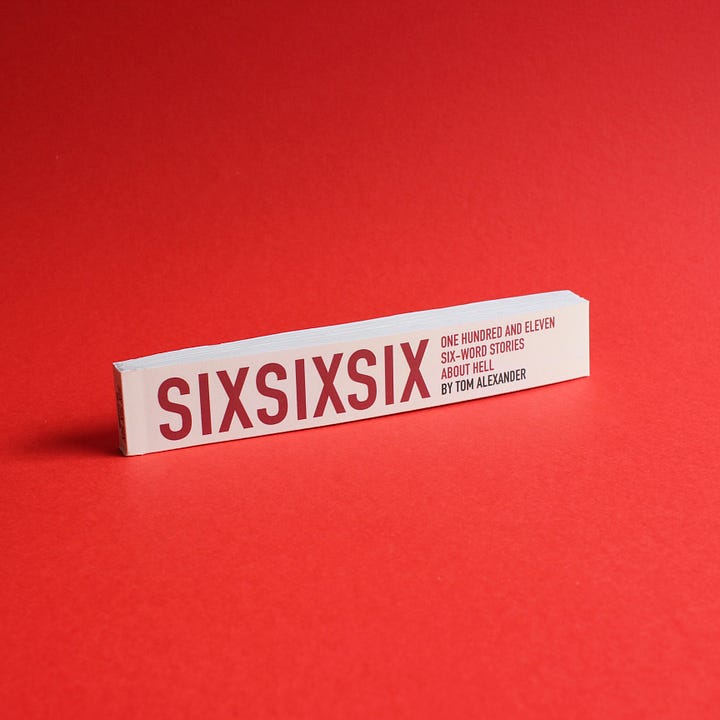
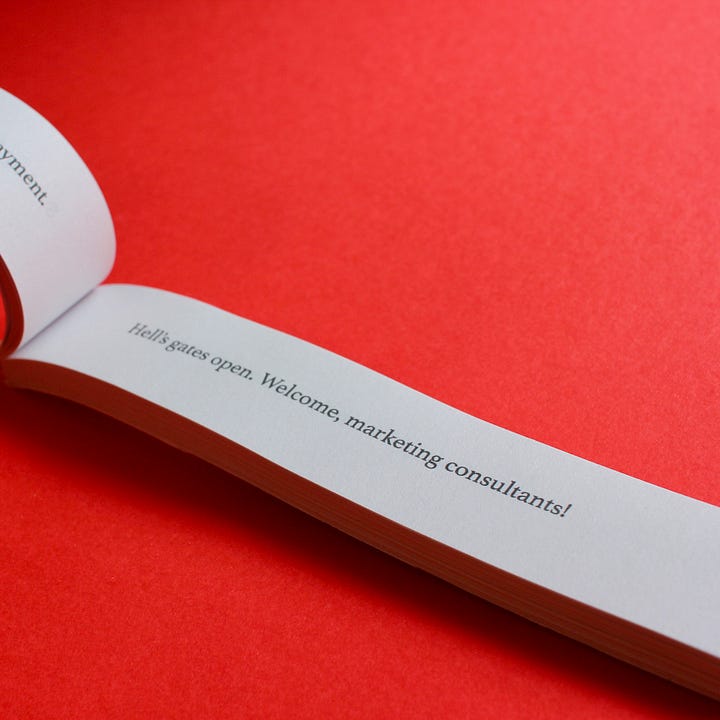
And you know what? It worked pretty well! They are not perfect but I’m happier with the cuts done by hand than I was with any of the machine-made ones. Sometimes the best solution is using the simple tools one has to hand. There’s a bit of variation in size, but I sort of like that these paperbacks are a half-way house between the handmade hardbacks and the computer generated PDFs which make up the third printing. There are 600 of these ebooks and each of these are also individually numbered. These cost just 66p (bargain!).
Let me tell you, making these turned out to be a real faff, possibly because I assumed it would be straightforward. The layout software I use allows for data merging, which I thought meant I could spit out 600 copies of the same file, each with an individual index number. Unfortunately, it doesn’t work like that. It wanted to make one file with all the pages in. That’s 72,000 pages, which means a biiiiig file that takes aaaaaages to process. A bit of wrangling later and I was able to get it sorted out, using a bit of Python code to merge various files together to make 600 individually numbered PDFs. I then had to find a way to sell the PDFs so that everybody got their own individually numbered one and not just a copy of the same file. I do not know how to do this, but thankfully I know someone who does. Huge thanks must go to Jemima Kingsley for putting together a sales system that meets my rather odd criteria and for doing so using free tools. She is a genius.
I’m pleased with this book. I like the way it all ties together, both narratively in the text and the different facets of the three editions. Feedback so far has been really positive and I hope people enjoy it.
Money isn’t everything
One of the things that delayed Six Six Six was getting a surprise commission to make a film for the Future of Money Design Awards. I’d put in a proposal a while ago and then thought nothing more of it until they gave me some money and told me to go make it. I haven’t really made a film in a while and wasn’t sure I had the resources to do so. Back when I was making films, digital video was insanely taxing on computers and we had a beefy workstation to handle it. I remember our editor bragging that the machine had a gigabyte of storage. Now, of course, you can edit 4k movies on your phone. I used the demo version of Final Cut Pro on my creaky laptop and it worked just fine.
The idea I’d pitched was an app that sits on top of contactless payment systems to give people information about where they were spending their money. So it might tell you a company’s environmental recorder, how they treat their employees or whether they avoid paying tax. More broadly, it might make comparisons about how else that money might be used in society, or what that amount of money might mean to people in different circumstances, or other parts of the world. The intention was to make people think about how and where they spend money, not to scold them or make them feel bad, but to make them aware of the power they have.
This was the idea and, to be honest, my initial concept for the film was a barely moving Powerpoint presentation with me talking over the top. This was stymied by the fact that I can’t bear the sound of my own voice and I have a very wet mouth, meaning that every recording is full of spitty cracks and pops which disgust me no end. It was the Amazing Octavia who reminded me of the old "show, don’t tell” rule, so I set about making a demonstration of the app at work. This was done with stock footage downloaded from Storyblocks and a bit of simple animation knocked up in Tumult Hype. These were intercut to a piece of annoying library music to give ‘Context’ even more of a corporate sheen.
Watch ‘Context is Everything’ on the Future of Money Design Awards website
It’s strange, the things you don’t realise you remember. I never had that great a feel for editing, but there’s some stuff that came back quite naturally, even after twenty-odd years. As annoying as that music was, it gave the piece a rhythm to cut to and makes everything flow much better.
Anyway, people seemed to like it. I went to the event at London and, in a faintly excruciating manner, give a small talk about my idea before an assembled crowd of financial people. Mine was one of four finalists and was awarded first prize. I got a nice shiny thing to take home and put on the mantelpiece.
Find out more about the Future of Money Design Awards at futuremoneyaward.com, including videos form all four finallists.
Ink Paper and Print Fair
Thanks to everyone who came to the Ink Paper and Print fair at Lewes Town Hall on the 25th of May. I feel deeply ashamed that I didn’t have a tablecloth, but apart from that, I think it went quite well. It’s always nice to see people interacting with the work and also to get a sense of what other people are making. There was a lot of really beautiful printmaking on display. (I’m not including myself in that - I have made my peace with the fact that I’m probably never going to be one of those people, but that hopefully my stuff is interesting in other ways.)
If you’re one of the people who signed up at the fair, hello, I’m not always this productive or busy. Also, I’ll be doing Artwave this year, so pop along to that if you’d like. (Artwave is a kind of artists open house thing. I have plans - vague, stupid plans - and will post details about the event nearer the time, which is September.)
Stuff I liked
Ripley on Netflix
I honestly thought this newsletter was going to be mostly about the Netflix adaptation of Ripley, which I really enjoyed. My first thought was that Andrew Scott was too old for the role of Tom Ripley, but as the series goes on it becomes clear that he’s really going for something. After finishing it, I re-watched the Anthony Minghella adaptation and the contrast with Matt Damon’s Ripley is marked. The 1990s film feels like it’s essentially a story about unrequited gay love, whereas in the Netflix series, Ripley doesn’t so much have a sexuality as an insect-like desire to consume his quarry. Matt Damon feels like a goofy kid learning to feel ok in his skin and just happens to kill a couple of people along the way. By comparison, Andrew Scott’s Ripley feels more like the xenomorph in the Alien films – evolving from a scrabbling cuttle fish into an embedded parasite until he reaches a final form of slick black carapace with acid for blood.
The film and the Netflix series feel so different that I went back to the Patricia Highsmith’s novel to see which adaptation was ‘truer’. It’s the miniseries, by far, but it’s interesting seeing how writer/director Stephen Zallian will take half a page of the novel and expand it into a whole episode. The series really gets deep into the mechanics of murder - all the details and process and dumb luck that goes into getting away with it.
This podcast features an interview with Stephen Zallian. Skip to about 21 minutes in (although it does have some spoilers).
Highly recommend it if you like crime drama, Italian architecture or black and white imagery.
Tank Gamers
Quite different, but no less impressive, is this person who has created a full set of controls for a tank videogame. And when I say ‘full set of controls’ I meant full set of controls, that need to be operated by a whole crew. There’s steering, a crank handle for rotating the turret, but most insanely/impressively, a gun that needs to be loaded with shells that are then ejected at high speed. These shells are full fizzy drink bottles, which gives them real heft. Seriously, watch this. It’s nuts.
If you can play WOT or WarThunder like this
The Köln Concert
I listened to a podcast about all the things that went wrong in the preparation for Keith Jarrett’s Köln Concert, including having the wrong piano, bad service in the restaurant next door and the pianist having cramp because he drove instead of flying to the concert. And yet, it all comes together in something great. I hadn’t heard of it, but it turns out it’s one of the best selling jazz albums of all time. Maybe read the Wikipedia article to get all the context, then listen to the album. I always like hearing musicians getting into it and hearing Jarrett’s occasional satisfied grunts or footstomps are just the icing on the cake for me.
Keith Jarrett - The Köln Concert on Apple Music
OK, that’s it for now. That’s been a lot. I’m looking forward to being a little less busy for a while. Need a bit of thinking space. Until next time, be well and enjoy the sunshine while you have it.
ta



